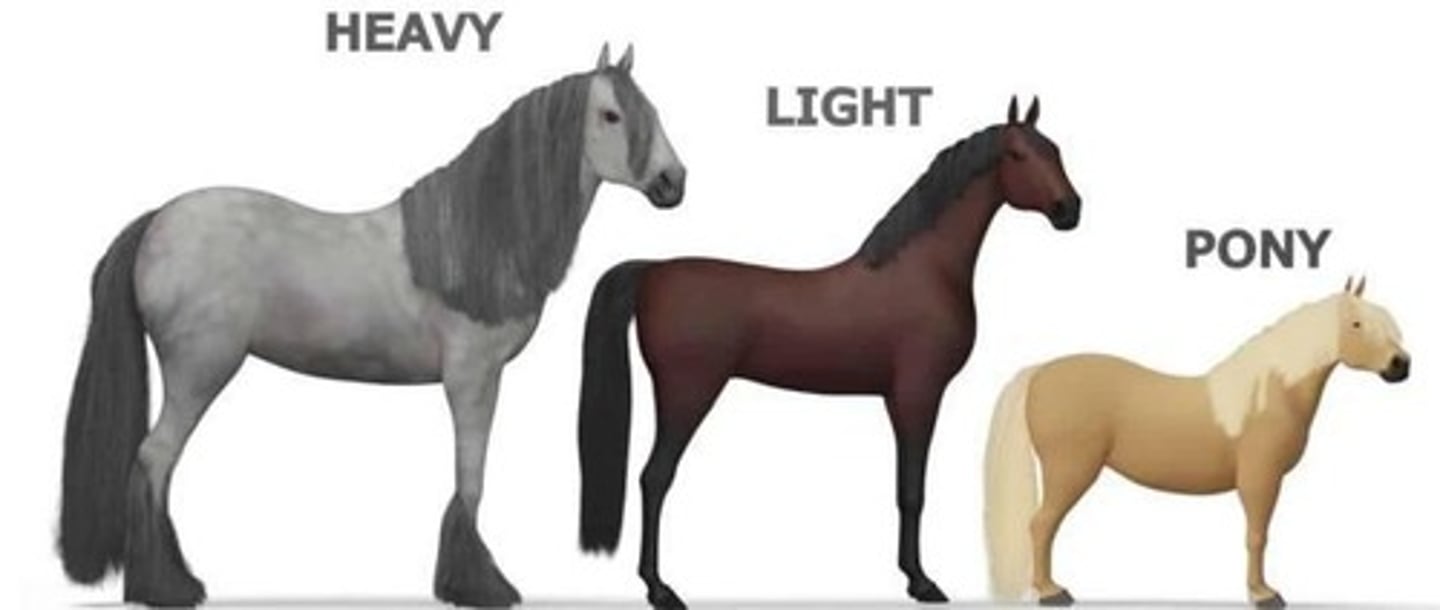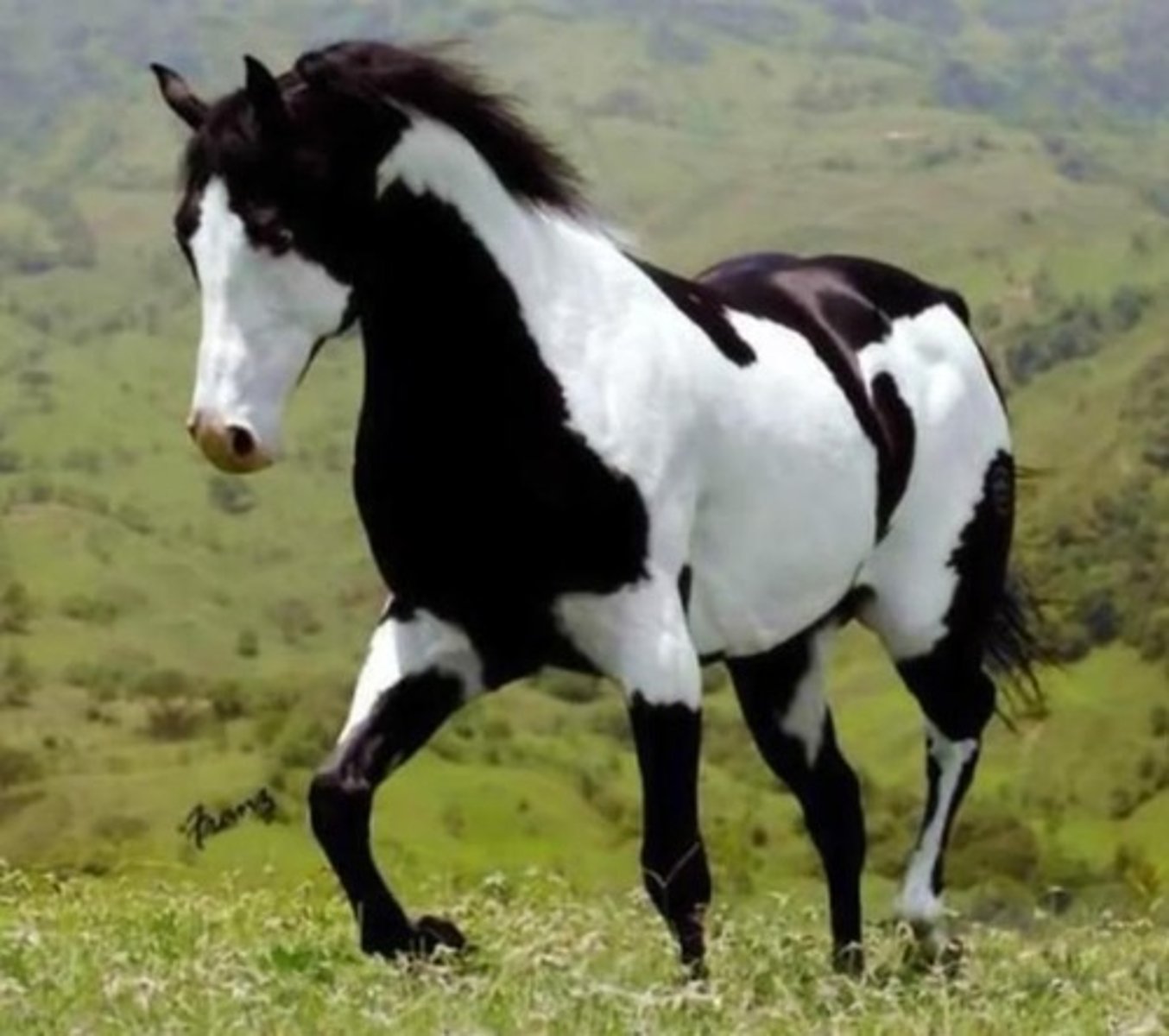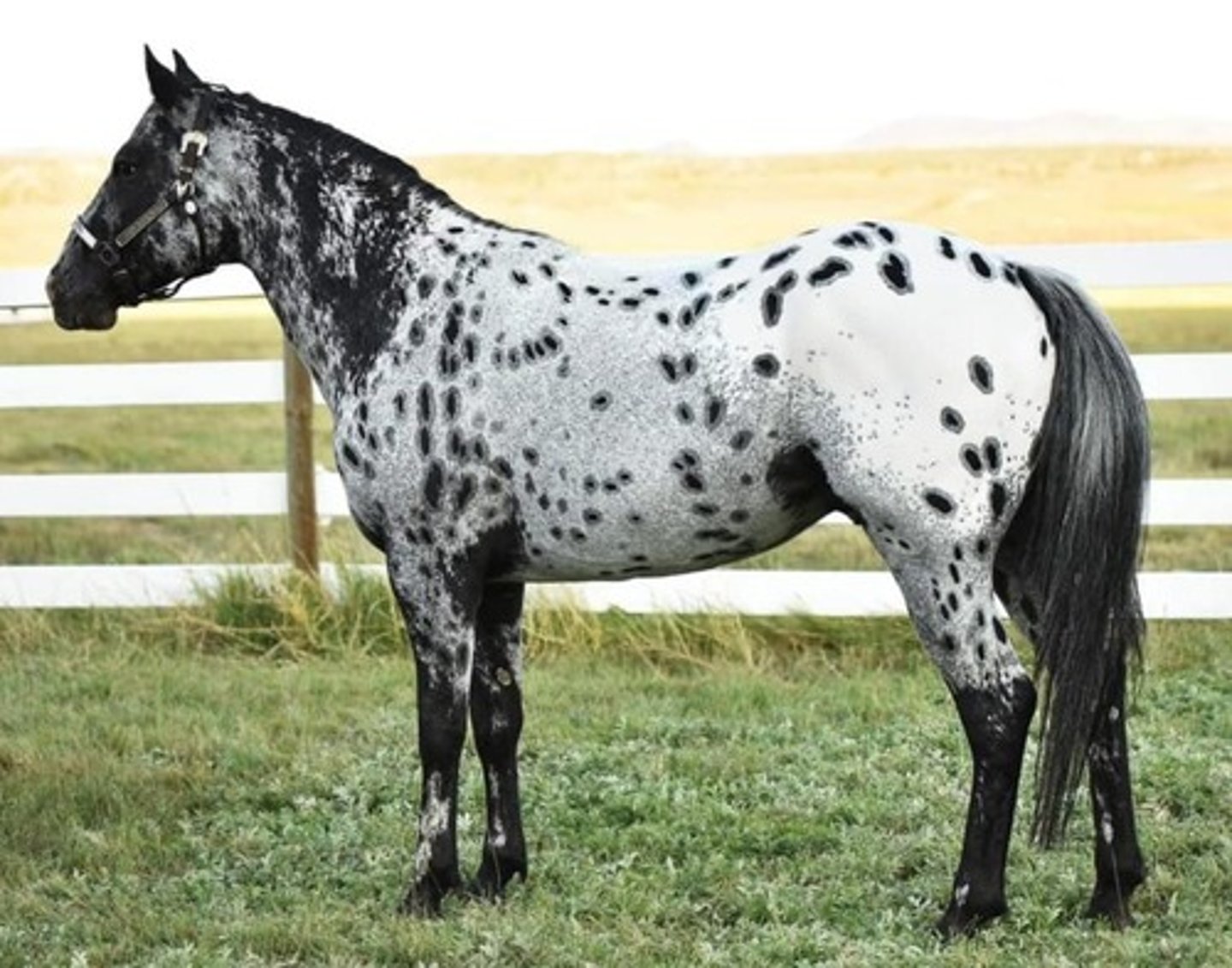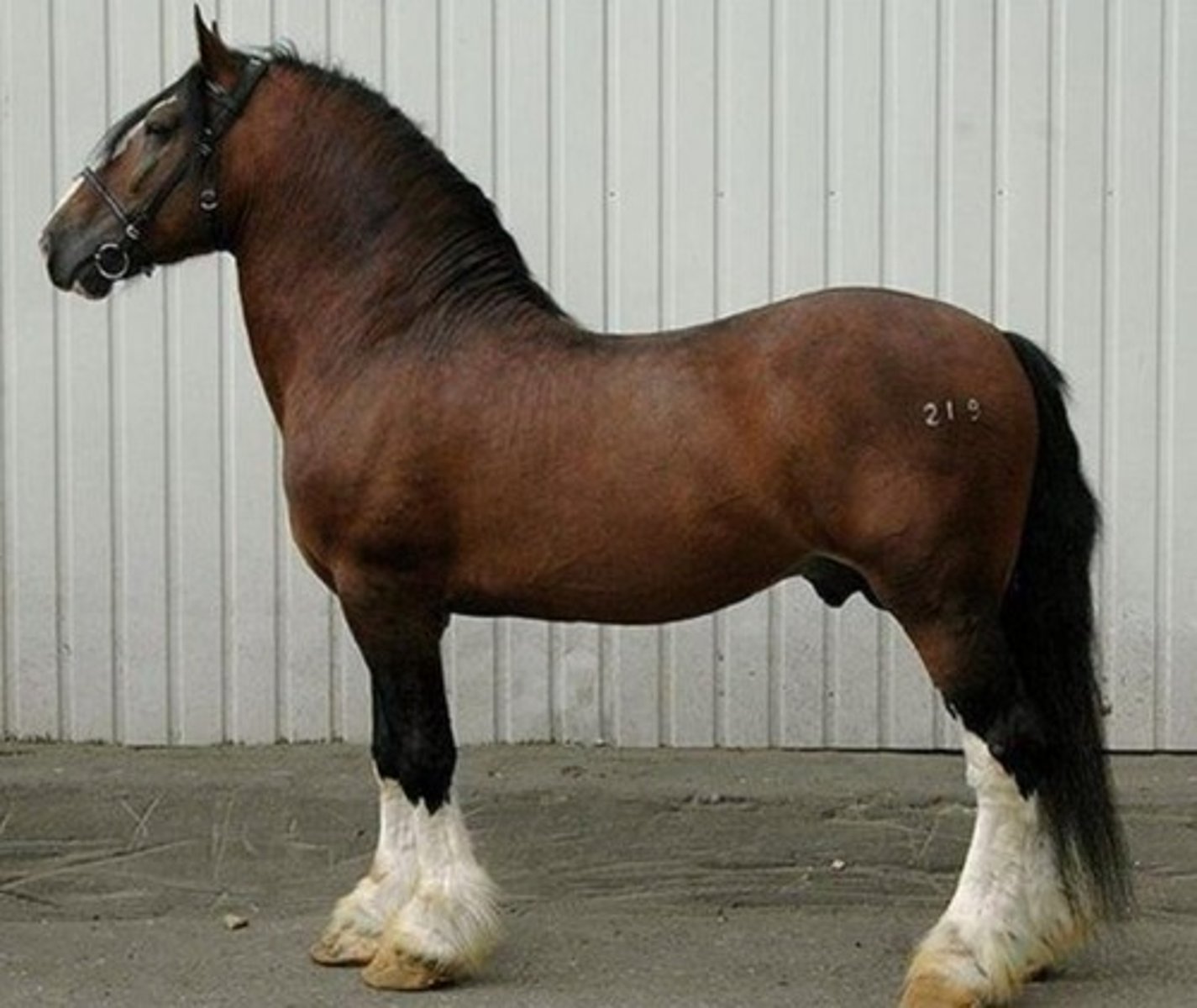Overview of Horse and Chicken Breeds
1/69
There's no tags or description
Looks like no tags are added yet.
Name | Mastery | Learn | Test | Matching | Spaced |
|---|
No study sessions yet.
70 Terms
Scientific name of horses
Equus caballus
Lifespan of horses
25-30 years
Speed
88 km/h (Maximum, Sprint)
Kingdom
Animalia
Order
Perissodactyla
Family
Equidae
Gestation period
11-12 months
Heavy horses
Large and strong horses.

Light horses
Slim and athletic horses built for speed and stamina.
Ponies
Small and stocky horses known for strength relative to size.
Difference between Horses and Ponies
Horses take longer to grow, are more quiet and docile, and more willing to work; Ponies live longer, are more stoic, wily, and intelligent, and good at avoiding work.
American Paint Horse
A breed combining the conformational traits of a western stock horse, featuring a pinto spotting pattern with white and dark-colored patches.

American Quarter Horse
An American breed known for sprinting short distances and excelling in quarter-mile races.
Speed of American Quarter Horse
Can reach speeds up to 55 km/h.
Size of American Quarter Horse
14.3 to 15.3 hands high (HH) (1 hand = 4 inches).
Trotters
Horses that move legs in diagonal pairs (left front + right hind).

Pacers
Horses that move legs on the same side together (left front + left hind).
Height range of horses
14 to 17 hands (56 to 68 inches / 142 to 173 cm), most are 15 to 16 hands (60 to 64 inches / 152 to 163 cm).
American Saddlebred Horse
A riding horse known for easy riding gaits, great vigor and style, and being a dominant breed in U.S. horse shows.
Weight of American Saddlebred Horse
400 to 450 kg.
Appaloosa Horse
A color breed popular in the U.S., known for its spotted coat and being trustworthy, gentle, and highly intelligent.

American Standardbred Horse
Known for beauty, personality, speed, and agility, excelling in harness racing.
Weight of American Standardbred Horse
Up to 2,000 lbs (900 kg).
Philippine Light Horse
Features an uneven head, short neck, chamfered shoulder, medium-length back, and bushy mane.
Arabian Horse
Originating from the Arabian Peninsula, known for spirit and endurance, with distinctive features like a small head and high tail carriage.
Quarter Horse
Most popular horse breed in the U.S., known as the fastest horse over short distances.
Thoroughbred
Originating from England in the 17th-18th century, best known for horse racing and traits like high spiritedness and athleticism.
Tennessee Walker
Origin: Southern United States (18th century)
Clydesdale Horse
A draft horse breed from Scotland, named after Clydesdale County. Height: 17-18 hands (68-72 inches / 173-183 cm)

Gaited breed
Known for smooth rides.
Famous gait
Four-beat 'running walk'.
Hot-blooded horses
Characteristics include being light, fast, energetic, very alert, and sensitive. Bred for speed and endurance.
Uses of Tennessee Walker
Used in racing and long-distance riding, historically by Civil War generals.
Today used as
Show horses and pleasure mounts.
Morgan Horse
One of the oldest U.S. breeds, small in size but strong-hearted.
Traits of Morgan Horse
Compact, brave, versatile, agreeable.
Uses of Morgan Horse
Used in farming, carriages, riding, and driving.
Cold-blooded horses
Big, strong, and calm; bred for heavy work and pulling.
Warmbloods
Not a single breed, but a group (e.g., Hanoverian, Holsteiner, Oldenburg, Trakhner).
Characteristics of Warmbloods
Medium build, calm but athletic, more balanced than hot- or cold-bloods.
Uses of Warmbloods
Used in jumping, dressage, and other equestrian sports.
Open stud book policies
Allow for mixing hot- and cold-bloods for sport and versatility.
Andalusian
Origin: Iberian Peninsula, Spain; recognized as a breed in the 15th century.
Features of Andalusian
Long, thick manes and tails; strong, compact, and elegant build.
Coat colors of Andalusian
Varied in the past; usually grey or bay in the present.
Uses of Andalusian
Dressage, driving, saddle seat, and jumping.
Chicken Breeds Distinction
Based on physical traits: size, plumage color, comb type, skin color, number of toes, amount of feathering, egg color, place of origin.
Chicken Breeds Grouping
Divided by primary use: for eggs, meat, ornamental, or dual-purpose.
Delaware
Was once set to become the main dual-purpose chicken.
Egg-Laying Breeds
Breeds known for their egg production capabilities.
Broiler breed of the U.S.
Lays 4 brown eggs/week, dresses out at 5 lbs, good forager, lays 100-150 brown-tinted eggs/year, depending on food and weather.
Australorp
Holds the world record for egg production in a year: 364 eggs.
New Hampshire
Origin: New Hampshire, USA. Bred for dual-purpose (egg and meat), dresses out at 5-6 lbs, lays 200-280 large brown eggs per year, more productive in colder months.
Buckeye
Origin: Ohio, USA (late 19th century). Dual-purpose breed; thrives in cold climates, lays about 200 medium-sized brown eggs per year.
Sussex
Origin: Sussex, England. Dual-purpose breed, lays 200-350 large light brown eggs per year.
Plymouth Rock
Known varieties: Barred and White. Lays 200-280 medium brown eggs per year, hardy in cold climates, lays year-round.
French Bresse
Category: Meat breed (also lays eggs).
Leghorn (Brown & White)
Origin: Tuscany, Italy (early 1800s). Dual-purpose breed, lays 280-300 large white eggs per year.
Cornish Cross Chicken
Category: Meat breed. Widely used in the meat industry.
Jersey Giant
Origin: New Jersey, USA (1870s). Largest purebred chicken: Roosters up to 13 lbs, hens up to 10 lbs, lays 150-200 large, light to medium brown eggs/year.
Polish Chicken
Category: Ornamental. Lays around 200+ medium white eggs/year, easy to handle and tame.
Brahma Chicken
Category: Known for friendliness. Lays about 150 medium brown eggs/year.
Cochin Chicken
Category: Ornamental. Low egg production: ~160 large brown eggs/year.
Sultan
Category: Ornamental.
Orpington Chicken
Category: Friendly/Calm breed. Poor egg layer.
Silkie
Known as 'chickens with fur' due to soft, fluffy feathers.
Faverolles Chicken
Category: Friendly/Comical breed; known to be talkative and curious.
Phoenix
German breed from Japanese Onagadori; known for long tail feathers.
Transylvanian Naked Neck (Turken)
Has no feathers on neck; moderate egg layer.
Onagadori
Original long-tailed Japanese breed; tails can reach up to 27 feet.